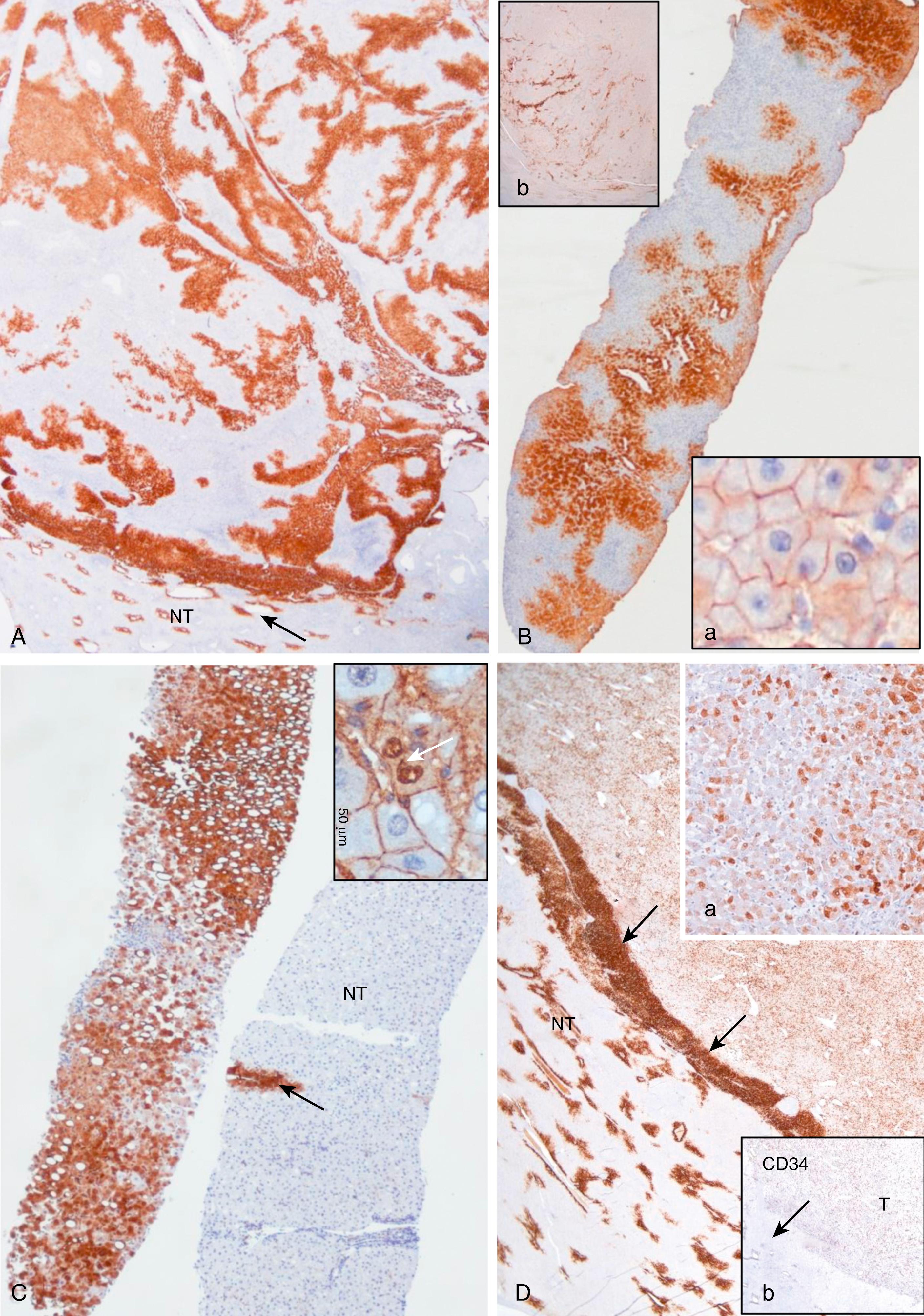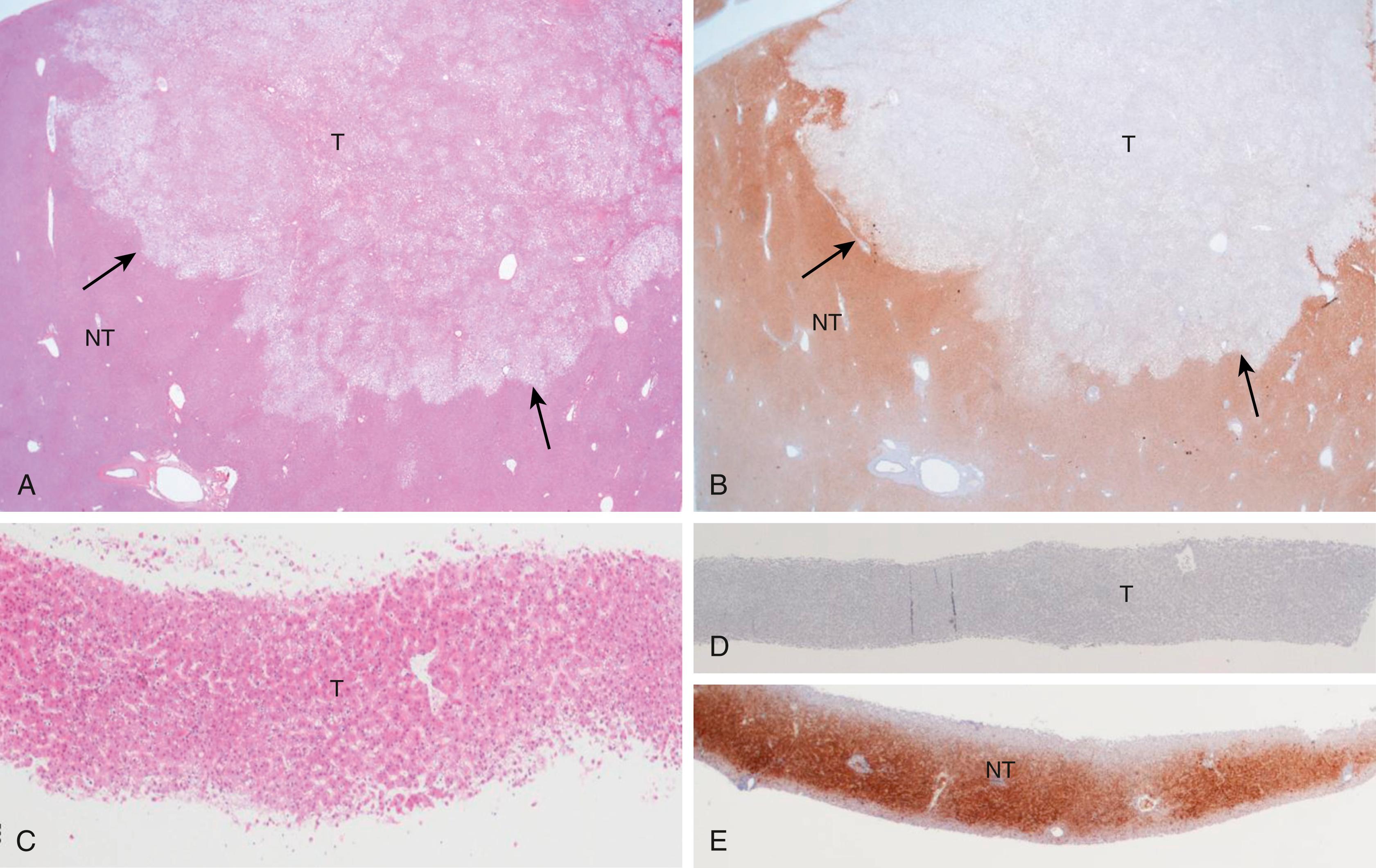Physical Address
304 North Cardinal St.
Dorchester Center, MA 02124
Identification of the molecular pathways altered in benign and malignant hepatocellular tumors has significantly increased our understanding of hepatocellular tumorigenesis. The immunohistochemical markers derived from these molecular alterations have been useful in clinical pathology practice, contributing to accurate diagnosis and classification of these tumors in resection and biopsy specimens.
Hepatocellular adenoma (HCA) and focal nodular hyperplasia (FNH) are benign hepatocellular tumors. HCA is a hepatocytic neoplasm, whereas FNH, which is much more frequent, is a hyperplastic hepatocytic response caused by localized hepatic vascular abnormalities.
FNH and HCA occur most frequently in women of childbearing age; these tumors are much less common in men, children, and postmenopausal women. Oral contraceptives are recognized as the main risk factor for HCA, whereas these agents are probably not etiologically implicated in FNH. The epidemiology of HCA has changed in recent years because low-dose contraceptive pills cause fewer cases of HCA than the pills used in the past. However, obesity and the metabolic syndrome are more frequently encountered in women and men with HCA, particularly the inflammatory subtype. , HCAs also occur in the setting of metabolic disorders such as glycogenosis type 1 and 3, galactosemia, tyrosinemia, and familial diabetes mellitus. Most cases of HCA occurring in men are associated with the administration of anabolic steroids to treat diseases or for bodybuilding.
FNH lesions, especially when multiple, may be associated with hepatic vascular disorders, hemangiomas, and other tumors of the liver or other organs. FNH and HCA usually develop in livers that are otherwise histologically normal, sometimes steatotic, or with features of vascular liver diseases. ,
The data regarding molecular aberrations in FNH are limited. Analysis of clonality using the human androgen receptor assay demonstrated the polyclonal nature of the hepatocytes in 60% to 100% of cases. Studies of chromosomal gains and losses using comparative genomic hybridization or allelotyping detected alterations in 14% to 50% of cases. However, genetic analysis failed to identify somatic gene mutations in CTNNB1 (which encodes β-catenin), TP53 (tumor protein 53), APC (adenomatous polyposis coli protein), and HNF1A (hepatocyte nuclear factor 1α). , ,
The mRNA expression levels of two angiopoietin genes, ANGPT1 and ANGPT2 , involved in vascular maturation are altered in FNH, and the consistently increased ANGPT1/ANGPT2 ratio supports the role of a vascular trigger for this lesion. , Studies have identified overexpression of genes encoding proteins of the extracellular matrix and cell–matrix adhesion, consistent with the finding of fibrosis in most cases of classic FNH. A twofold overexpression of the TGFB1 gene was detected, and other key genes involved in the fibrogenesis pathway, such as PDGFA and PDGFRB , were found overexpressed in FNH. The finding of myofibroblasts expressing smooth muscle actin at the periphery and in the fibrotic areas of FNH is consistent with activation of the transforming growth factor-β (TGF-β) pathway in these cells. The NTS gene, which encodes neurotensin, is overexpressed in FNH, resulting in an increased ratio of NTS to HAL, a periportal area gene that encodes histidine ammonia lyase. This finding can discriminate FNH from other benign tumors.
Alterations in the expression of physiologically zonated genes of the hepatic lobule have been detected in FNH. Thirteen genes of the periportal areas were found to be downregulated, whereas six genes of the perivenous areas were upregulated, indicating altered zonation in FNH. One of the perivenous area genes, GLUL , which encodes glutamate-ammonia ligase, also known as glutamine synthetase (GS), is upregulated by β-catenin. GLUL mRNA overexpression correlates with a slight but significant CTNNB1 mRNA overexpression in FNH compared with normal liver parenchyma; this upregulation of the β-catenin signaling pathway is restricted to areas surrounding the veins of FNH nodules and occurs in the absence of CTNNB1 -activating mutations.
It has been suggested that increased arterial inflow in FNH may contribute to activation of the β-catenin pathway. However, the mechanism of β-catenin activation in FNH remains unresolved, because no alteration of the main known regulators of the WNT signaling pathway have been identified, including a lack of AXIN1 and APC inactivating mutations.
FNH-like nodules are lesions resembling FNH macroscopically and on imaging, but they occur in cirrhotic livers , or in the setting of vascular hepatic disorders such as Budd-Chiari’s syndrome. , , The gene expression profile of FNH-like nodules in cirrhosis is significantly different from that of classic FNH. The nodules do not show β-catenin activation, and the β-catenin–induced perivenous genes are significantly downregulated compared with those of nontumorous liver and classic FNH. The periportally zonated genes are not differentially expressed compared with nontumorous liver as determined by quantitative reverse transcription–polymerase chain reaction (RT-PCR), and the NTS/HAL expression ratio is not increased, as observed in classic FNH.
As a consequence of the deregulation of the β-catenin pathway, overexpression of GS is heterogeneously distributed in the hepatocytes of the FNH nodules. This can be demonstrated with immunohistochemical techniques, as characteristic staining with relatively large areas anastomosed in “maplike” patterns ( Fig. 45.1A,B ). The GS-positive areas often predominate at the periphery of FNH, are often centered on veins, and are usually located at a distance from the fibrous bands. This specific pattern of GS staining in FNH contrasts with that of normal liver, in which staining is restricted to a few rows of hepatocytes surrounding the terminal hepatic venules ( Fig. 45.1A ,C,D). Owing to the absence of β-catenin (CTNNB1) mutations, immunohistochemistry using a β-catenin antibody does not show abnormal cytoplasmic or nuclear β-catenin staining, even in hepatocytes overexpressing GS (see Fig. 45.1B , inset a ). The characteristic GS immunostaining and the lack of aberrant β-catenin expression provide a useful tool for the diagnosis of some FNH lesions that lack typical histological features in surgical specimens or biopsies.

As expected from their molecular changes, FNH-like nodules show little or no parenchymal GS immunostaining. When present, GS staining is usually restricted to some persistent venous structures inside the nodules (see Fig. 45.1B , inset b ). This staining pattern is similar to that of cirrhotic nodules and quite different from that of the large, anastomosing, GS-positive areas of classic FNH.
HCAs are a heterogenous group of monoclonal tumors in which several recurrent mutations have been identified, leading to a classification based on good genotypic-phenotypic correlations with important consequences for patient management. Hemorrhage (20% to 25%) and malignant transformation (4% to 8%) are observed mainly in HCA >5 cm. The risk of malignancy exists particularly for HCA with high activation of the β-catenin pathway, but this occurs rarely in other HCA subtypes (see later). Molecular changes and diagnostics are described for each HCA subtype.
The HNF1A gene (formerly hepatic transcription factor 1 [ TCF1 ]) is located on chromosome 12q24.2 and encodes the hepatocyte nuclear factor 1α protein (HNF1A), a 681-amino acid homeodomain transcription factor that is involved in hepatocyte differentiation. HNF1A controls the expression of liver-specific genes, such as those for β-fibrinogen (FGB) , α 1 -antitrypsin, and albumin (ALB) . HNF1A is a human tumor suppressor gene involved in liver tumorigenesis.
Biallelic inactivating HNF1A mutations have been detected in 30% to 35% of HCAs. In most cases, both mutations are of somatic origin, but in less than 10% of cases, one mutation is germline and the other somatic. Sporadic HNF1A-inactivated HCAs (H-HCAs) with somatic mutations occur almost exclusively in women and usually are associated with oral contraception. Patients with heterozygous germline HNF1A mutations are younger than those with somatic mutations, are either male or female, and frequently have a family history of liver adenomatosis or diabetes (usually maturity-onset diabetes of the young type 3 [MODY3]), which is a consequence of heterozygous germline HNF1A mutations. The spectrum of HNF1A somatic mutations in H-HCA differs significantly from the germline changes in MODY3.
Transcriptomic analysis showed that several metabolic pathways are altered in sporadic H-HCA, including neoglycogenesis repression, glycolysis, and fatty acid synthesis activation. The induction of glycolysis and lipogenesis in H-HCA is linked to HNF1A inactivation and is independent of the activation of sterol regulatory element–binding protein 1 (SREBP1) and MLX interacting protein-like (formerly called carbohydrate response element–binding protein [ChREBP]), leading to the characteristic steatotic phenotype of these tumors. Genes for fatty acid binding protein 1 (FABP1) and UDP glucuronosyltransferase 2-B7 (UGT2B7) are positively regulated by HNF1A and are downregulated in H-HCA. ,
Heterozygous, germline, inactivating mutations of CYP1B1 have been detected in 15% of women with H-HCA, suggesting that deregulation of the enzyme, which is responsible for the formation of genotoxic metabolites of estrogens, may confer a predisposition to sporadic H-HCA in women. CYP1B1 mutation modifies the penetrance of the liver adenomatosis phenotype in patients with HNF1A germline mutations.
Downregulation of the FABP1 gene leads to a lack of liver-type fatty acid binding protein 1 (LFABP) expression in H-HCA, contrasting with normal expression in the surrounding nontumorous liver as demonstrated by immunohistochemistry. In addition to steatosis, which is common in H-HCA cases, the absence of LFABP expression is an excellent marker for the diagnosis of this subtype of adenoma in resection specimens and biopsy samples ( Fig. 45.2 ), irrespective of the degree of steatosis or size of the lesion. This feature also allows the diagnosis of HNF1A-inactivated adenomatosis to be made when multiple HCAs of various sizes are found throughout the liver. They are often associated with myriad steatotic microadenomas, which can be correctly identified by the lack of LFABP staining. ,

Become a Clinical Tree membership for Full access and enjoy Unlimited articles
If you are a member. Log in here